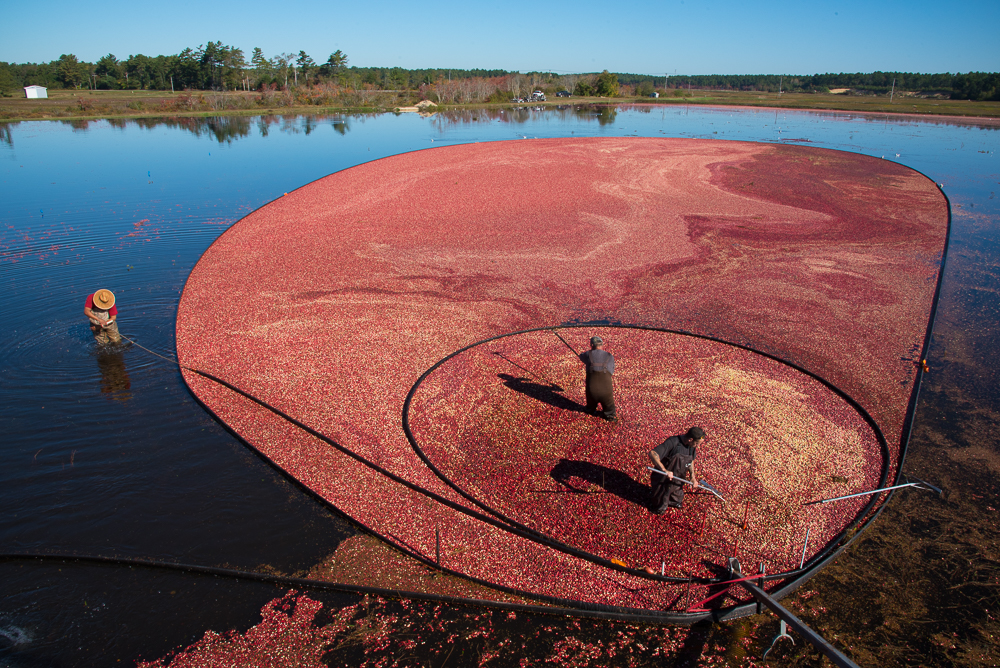
“How do you like the harvest?” Cas Gilmore asks as he grins ear-to-ear. He's a sixth generation cranberry farmer; his great-great-great grandfather, John Makepeace, was one of the three founding fathers of the Ocean Spray cooperative back in 1930.
Right now, we’re both wading to our knees in his family’s flooded cranberry bog in Carver, Massachusetts.
In truth, I love it. I’m living out a dream I didn’t even realize I had -- what I can only imagine is akin to what it's like to star in an Ocean Spray commercial. All I want to do is fall backwards into the bog or do a cannonball into the "red sea." Something's holding me back, though, as I try to convince myself that the next-level amount of baby wolf spiders -- in the bog, on the berries, crawling up our waders into our hair -- isn't freaking me out. Before I can answer, Cas follows up with "How do you like the spiders?"
I shimmy through the bog, hoping that it helps deter the arachnids from anchoring onto me. "Yeah, not much," I reply. "Not loving the spiders at all.”
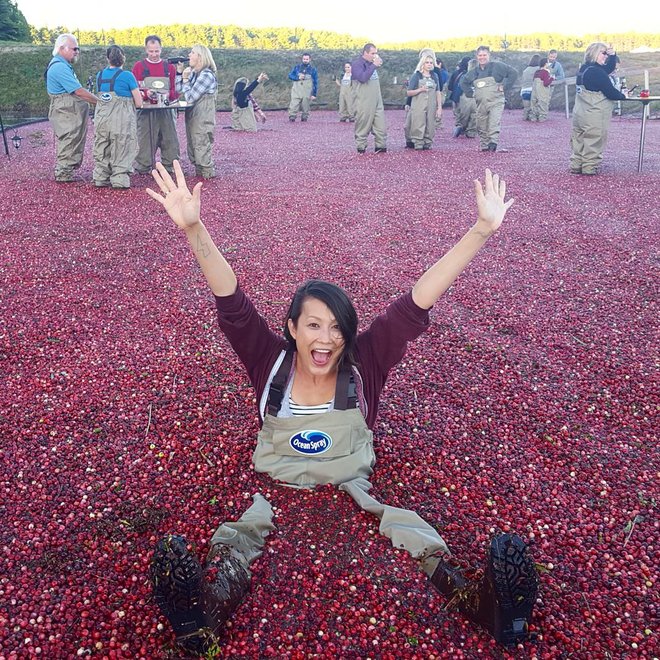
It’s my second time sliding into the waterproof waders and sloshing through the bright, bobbing berries. I’d gotten my first introduction to the bog during the previous night’s inaugural “Bog-to-Table” dinner, hosted by the A.D. Makepeace Company on their family-owned bogs. That night I’d practically torn away from the group upon arrival, jumping into a pair of waders before heading straight into the bog, which was cleverly set up like a bar and featured an impressive selection of cranberry booze.
There were fewer spiders then; I’d even sat down in the shallow bog for that ecstatic “look I’m in a bog!” photo. As I waded around, kicking gleefully in the water, snapping a million photographs, and loving life, it dawned on me that the cranberry is a relatively neglected all-American fruit. In fact, as a fruit with such deep history — it’s one of our country’s few commercially grown native fruits, and it has appeared on our tables since the first Thanksgiving dinner (and was used by Native Americans long before that) — we don’t know much about it.
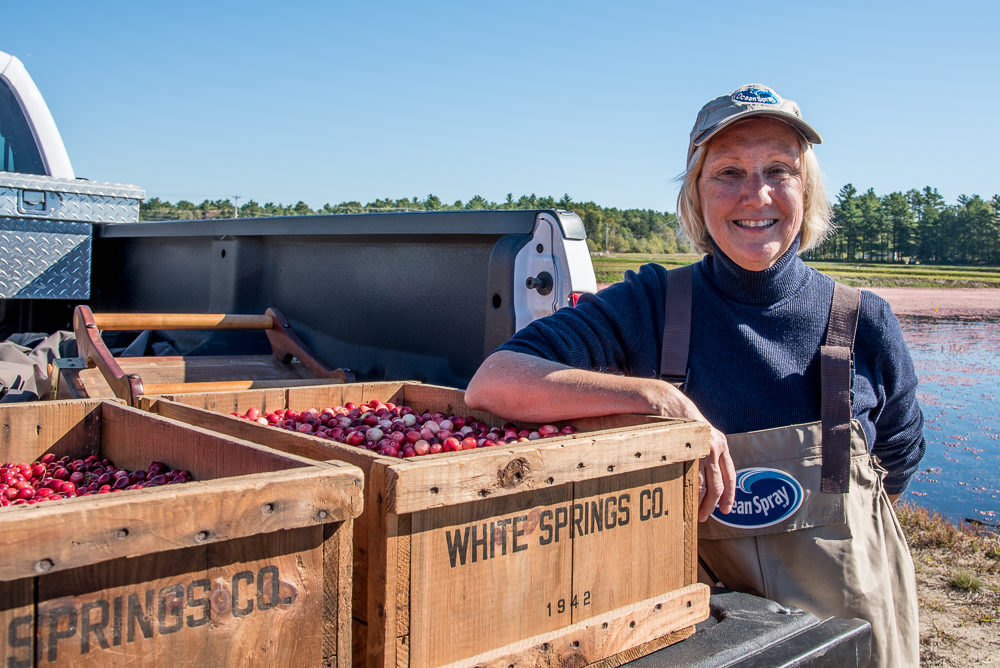
Even now, as I stand knee-deep in spiders, cranberries, and the harvesting season, it starts to hit me how much labor and love goes into this tiny little fruit.
Though you’re likely to only see fresh cranberries in stores around the holidays, the Gilmore family matriarch, Sue Gilmore, clues us in to the fact that her family works year-round to cultivate their cranberry crop. That’s seven days a week during high season and five days a week during the fruit’s dormant winter months.
Now it’s October, smack dab in the middle of a harvest season that starts around mid-August and ends in early November. We’ve missed the harvesting season for white cranberries, which are the first variety ripe for the picking, but we are right on time to participate in the wet and dry harvests of the colorful red varieties like Early Blacks, Stevens, and Howes.
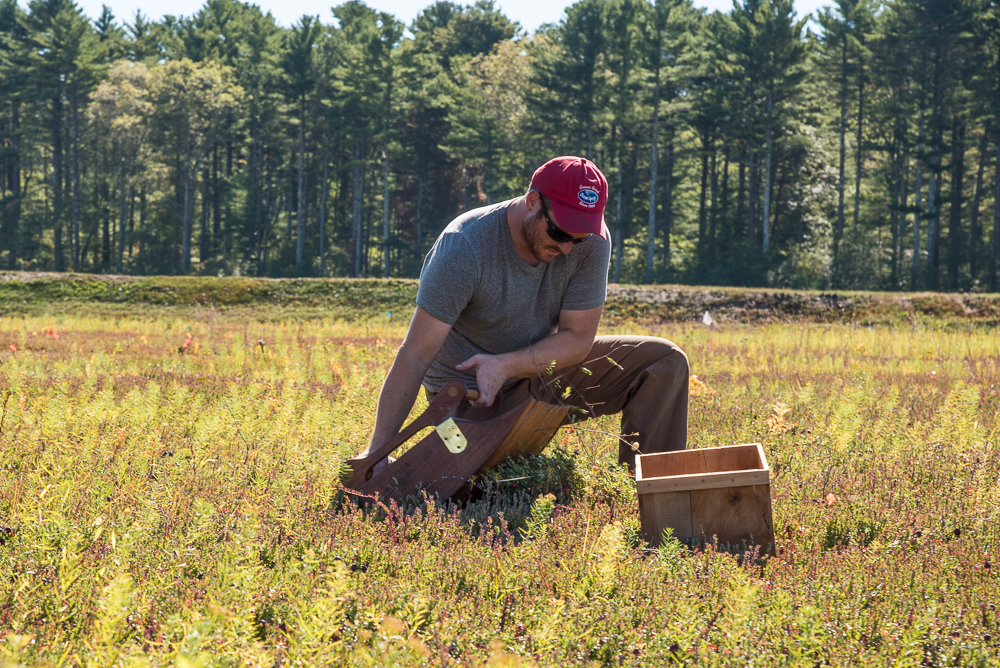
Contrary to what most of us believe, cranberries are not grown in water; they’re grown dry, on dense shrub-like vines. When we walk over the ripe fields, I can hear berries pop under the pressure of my red wellies. Ben Richards, a cousin of the Gilmore family and one of the five year-round workers on the 150-acre farms, is showing us how to dry harvest berries using a turn-of-the-century, handheld wooden cranberry scoop.
It looks like a slightly curved, large-toothed comb with a basket on the end, and I’m told to brush the comb through the vines with a slight rocking motion to separate the cranberries from the vines before dumping them into a wooden crate. I quickly learn it’s a lengthy and laborious process that yields a gorgeous but minimal amount of fruit. Even using today’s mechanical dry pickers, which look a lot like large lawnmowers, dry picking only harvests about a third of the available crop.
I take a cue from Ben and pop a few of the crunchy, tart berries into my mouth. Did you know that a cranberry is hollow inside? That’s what allows it to float, and ultimately what makes wet harvests possible.
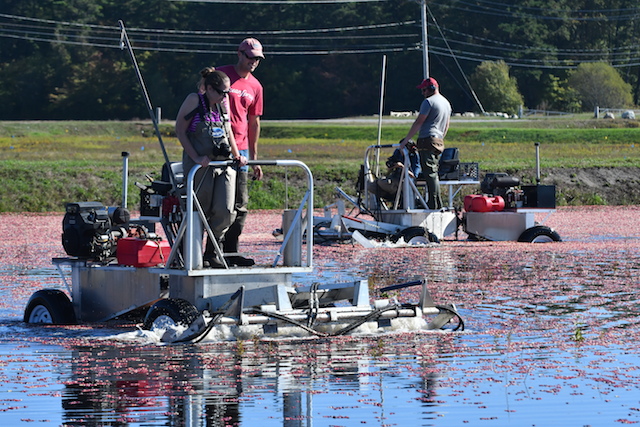
Once the berries are plump and ripe for the picking, farmers flood the bog with water, just above the tops of the vines, and go in with large metal machines called “egg beaters” or “pickers” to loosen the berries from the vines.
I hop on a picker with Ben and we drive into the flooded bog, following a line of wooden stakes that Cas, who is in the picker ahead of us, has thrust in the water to guide us. We move in a boxed spiral path while the picker churns underwater, and I watch as we leave a trail of bobbing berries in our wake.
Wet harvesting wasn’t discovered as a viable technique until the 1960s, but now it’s used by the majority of cranberry growers for harvesting the majority of their crop. In Massachusetts, dry harvests account for only 10 percent of a grower’s crop, while wet harvesting — which produces berries for juicing and processing into other food products like Craisins — accounts for the remaining 90 percent.
Now that we’ve loosened the berries, it’s time to corral them together to be sucked up onto the loading truck — and that’s where the spiders come in.
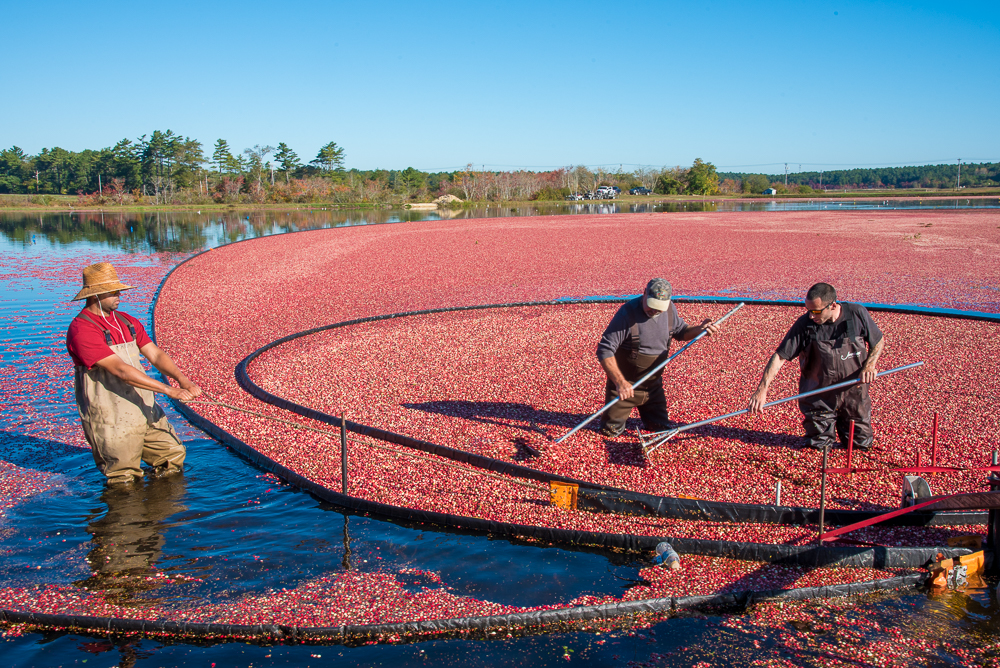
Actually, they’ve been there all along. While the berries are growing, budding, and flowering, the spiders make home in the vines, cleaning the vines of any insects. When the bogs are flooded, the spiders float to the surface and run across the tops of the berries to stay dry.
So, like the spiders, I’m currently standing in the middle of a wet harvest, just trying to keep up. I’m not paying attention to all the action around me. At one point I’m trying to get that perfect shot, and at another, I’m raking and pushing the berries toward the suction hose that takes them to the large loading truck parked next to the bog. I don’t notice that the section of cranberries I’m in is shrinking, getting smaller and smaller. The cranberries are being corralled by a floating vinyl boom that is being dragged across the bog in an ever-tightening circle.
By the time I look up, it’s the size of a claustrophobic kiddie pool and they’re telling us to get out.
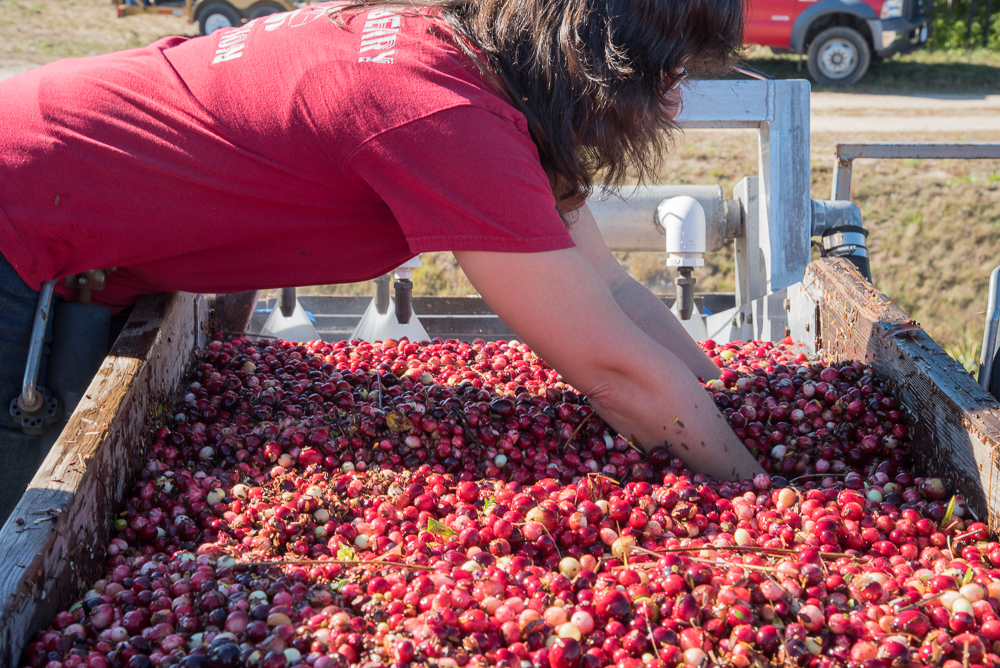
From the top of the truck, the bog is gorgeous; different shades of red look like spilled paint on a black canvas. It’s loud. Behind me, Sue and another woman are elbows deep in a trough of cranberries fresh from the bog. They’re pulling out leaves and vines and who knows what else (spiders?!) before the berries run through a final power spray wash and bounce down into the truck bed.
Sadly, I don’t have the guts to join them.
Before leaving the farm, we are invited into a barn where Sue and Ben excitedly start up an old-fashioned (though never-used) electronic separator. Ben pours a box of our dry-harvested berries into the top and they bounce down as the machine drops bad berries into a trough below. There are two conveyor belts that carry the remaining berries to our fingers for manual inspections, and then eventually drop the good berries into wooden crates resting on the floor.
I grab a couple off the belt and toss them into my mouth, savoring the bitter taste of the literal fruit of this harvest season’s love and labor.
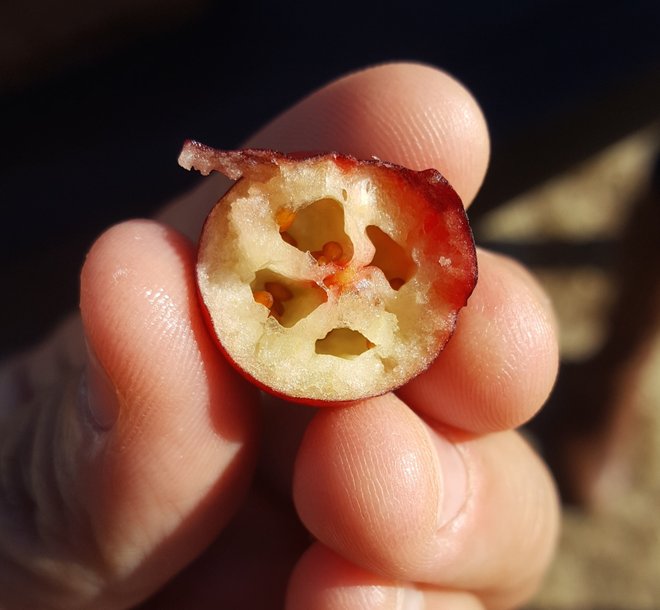
We spend the evening at the Gilmore home, eating and drinking a cranberry-infused menu of passed-down recipes in their gorgeous barn, listening to family stories, and laughing with friends. This family eats, breathes, and bleeds cranberries; can trace their lineage back to the Mayflower; and gives thanks to this tart and tiny native fruit — spiders and all — all year long.
There are several opportunities for you to get in a pair of waders and splash around in a cranberry bog. Five states across the U.S. grow cranberries — Massachusetts, Wisconsin, New Jersey, Washington, and Oregon — and have yearly festivals where you can get up close and personal with the tiny tarts and/or sample homemade jams, juices, and other treats made from local cranberries. In the meantime, travel to the store and pick up a pack of fresh berries while they are in season.
Related Links:
- Where to Travel in November, According to Experts
- Eat Your Way Through the World’s Coolest Food Markets
- The Best Fall Hikes in the U.S.
All products are independently selected by our writers and editors. If you buy something through our links, Oyster may earn an affiliate commission.



